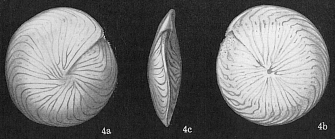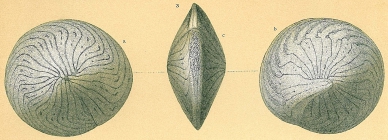
| Intro | | Search taxa | | Browse taxa | | Distributions | | Terminology | | References | | Statistics | | Online sources | | Tutorial | | Log in |
Foraminifera taxon detailsAmphistegina d'Orbigny, 1826
112080 (urn:lsid:marinespecies.org:taxname:112080)
accepted
Genus
Amphistegina quoyi d'Orbigny, 1826 accepted as Amphistegina radiata (Fichtel & Moll, 1798) (type by subsequent designation)
Omphalophacus Ehrenberg, 1839 · unaccepted (Subjective junior synonym Opinion...)
Subjective junior synonym Opinion of Loeblich & Tappan, 1987
marine,
recent + fossil
feminine
Orbigny, A. D. d'. (1826). Tableau méthodique de la classe des Céphalopodes. <em>Annales des Sciences Naturelles.</em> vol. 7: 96-169, 245-314., available online at http://biodiversitylibrary.org/page/5753959
page(s): p. 304 [details]
Diagnosis Test low trochospiral, lenticular and inequally biconvex, may be bi-involute or partially evolute on the spiral side,...
Diagnosis Test low trochospiral, lenticular and inequally biconvex, may be bi-involute or partially evolute on the spiral side, chambers numerous, broad, and low, strongly curved back at the periphery to form chamber prolongations, interior of all chambers with primarily formed toothplate that extends from the apertural face to about the middle of the previous septum and almost completely divides the chamber lumen, contact of the toothplate with the wall of the umbilical side producing a stellate pattern like that of Asterigerina although commonly more irregular due to the twisting of the toothplate, distinct umbilical plug present, periphery angular to carinate; wall calcareous, optically radial, finely perforate, surface smooth other than the papillae in the apertural region; aperture an interiomarginal slit on the umbilical side, bordered by a lip, those of preceding chambers serving as intercameral foramina, surface of the preceding whorl just beneath the aperture covered with fine papillae or rugae oriented in the direction of growth. Eocene to Holocene; cosmopolitan. (Loeblich & Tappan, 1987, Foraminiferal Genera and Their Classification) [details]
Hayward, B.W.; Le Coze, F.; Vachard, D.; Gross, O. (2021). World Foraminifera Database. Amphistegina d'Orbigny, 1826. Accessed at: http://www.marinespecies.org/foraminifera/aphia.php?p=taxdetails&id=112080 on 2024-12-21
Date action by 2006-09-05 08:30:55Z changed Martinez, Olga
original description
Orbigny, A. D. d'. (1826). Tableau méthodique de la classe des Céphalopodes. <em>Annales des Sciences Naturelles.</em> vol. 7: 96-169, 245-314., available online at http://biodiversitylibrary.org/page/5753959
page(s): p. 304 [details] original description (of Omphalophacus Ehrenberg, 1839) Ehrenberg, C.G. (1839). Über die Bildung der Kreidefelsen und des Kreidemergels durch unsichtbare Organismen. <em>Abhandlungen der Königlichen Akademie der Wissenschaften zu Berlin, Physikalische Klasse.</em> 1838: 59-147, pls. 1-4., available online at https://www.biodiversitylibrary.org/page/29017435 page(s): Chart opp. p. 120, p. 132 [details] basis of record Gross, O. (2001). Foraminifera, <B><I>in</I></B>: Costello, M.J. <i>et al.</i> (Ed.) (2001). <i>European register of marine species: a check-list of the marine species in Europe and a bibliography of guides to their identification. Collection Patrimoines Naturels,</i> 50: pp. 60-75 (look up in IMIS) [details] additional source Neave, Sheffield Airey. (1939-1996). Nomenclator Zoologicus vol. 1-10 Online. <em>[Online Nomenclator Zoologicus at Checklistbank. Ubio link has gone].</em> , available online at https://www.checklistbank.org/dataset/126539/about [details] additional source Loeblich, A. R.; Tappan, H. (1987). Foraminiferal Genera and their Classification. Van Nostrand Reinhold Company, New York. 970pp., available online at https://books.google.pt/books?id=n_BqCQAAQBAJ [details] Available for editors ecology source Reiss, Z.; Hottinger, L. (1984). The Gulf of Aqaba. <em>Ecological Studies.</em> , available online at https://doi.org/10.1007/978-3-642-69787-6 [details] Available for editors  Present Present  Inaccurate Inaccurate  Introduced: alien Introduced: alien  Containing type locality Containing type locality
From editor or global species database
Diagnosis Test low trochospiral, lenticular and inequally biconvex, may be bi-involute or partially evolute on the spiral side, chambers numerous, broad, and low, strongly curved back at the periphery to form chamber prolongations, interior of all chambers with primarily formed toothplate that extends from the apertural face to about the middle of the previous septum and almost completely divides the chamber lumen, contact of the toothplate with the wall of the umbilical side producing a stellate pattern like that of Asterigerina although commonly more irregular due to the twisting of the toothplate, distinct umbilical plug present, periphery angular to carinate; wall calcareous, optically radial, finely perforate, surface smooth other than the papillae in the apertural region; aperture an interiomarginal slit on the umbilical side, bordered by a lip, those of preceding chambers serving as intercameral foramina, surface of the preceding whorl just beneath the aperture covered with fine papillae or rugae oriented in the direction of growth. Eocene to Holocene; cosmopolitan. (Loeblich & Tappan, 1987, Foraminiferal Genera and Their Classification) [details]
|






